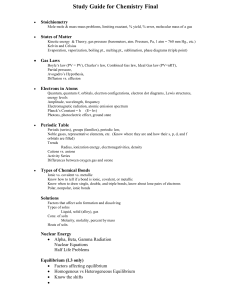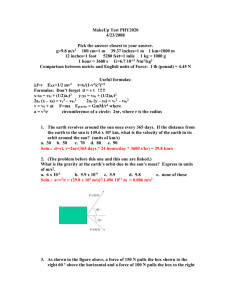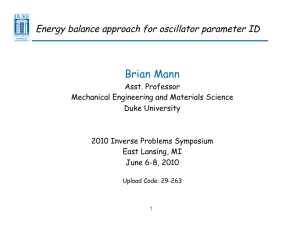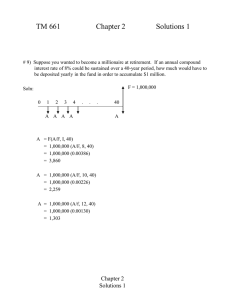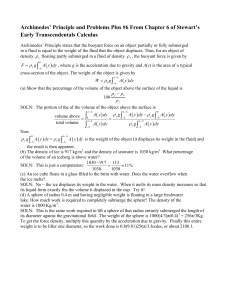Final exam Solutions, Physics 2a, 2010
advertisement
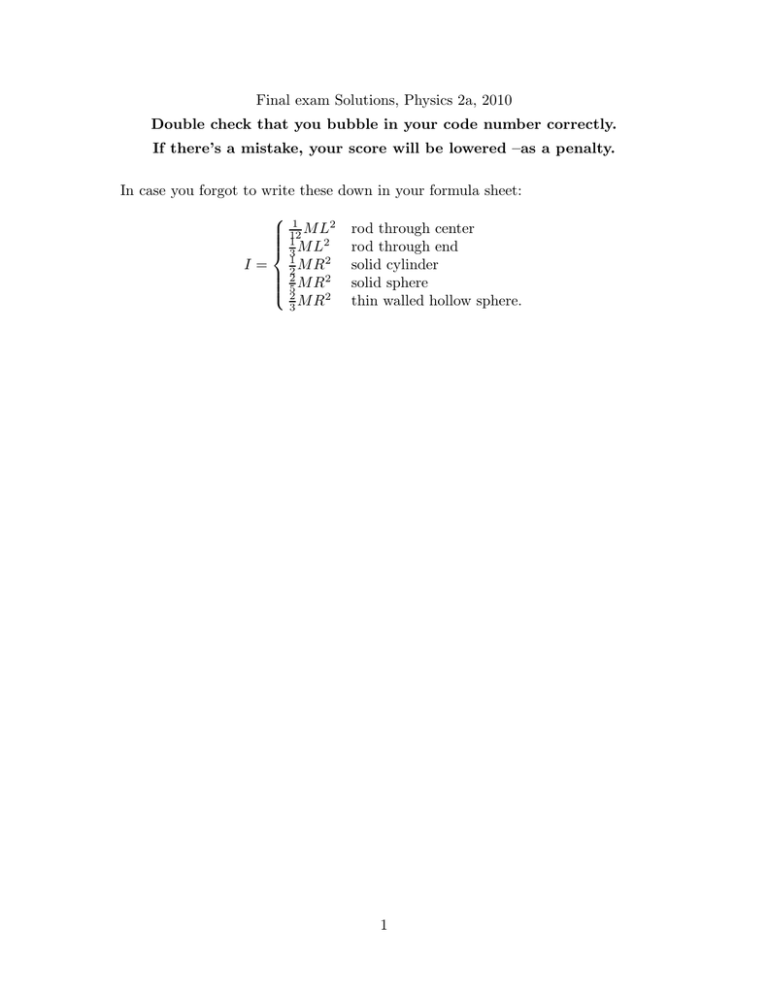
Final exam Solutions, Physics 2a, 2010 Double check that you bubble in your code number correctly. If there’s a mistake, your score will be lowered –as a penalty. In case you forgot to write these down in your formula sheet: 1 M L2 12 1 3 M L2 I = 21 M R2 2 M R2 52 2 3MR rod through center rod through end solid cylinder solid sphere thin walled hollow sphere. 1 VERSION A 1. Let ~v1 = 3bi + 4b j and ~v2 = 3bi − 4b k. What is the angle between these two vectors? (a) cos−1 (3/5). (b) sin−1 (9/16). (c) cos−1 (9/25). (d) sin−1 (3/4). Soln: ~v1 · ~v2 = 9 = v1 v2 cos θ, with v1 = v2 = 5, so θ = cos−1 (9/25). 2. A student is on the top of a building with two eggs and a stopwatch. The first egg is dropped with zero initial velocity and takes 2s to hit the ground. The second egg is thrown downward and is timed to take 1s to hit the ground. What was the approximate initial downward velocity of the second egg? (a) 10 m/s (b) 15 m/s (c) 20 m/s (d) 5m/s Soln: h = 21 g(2s)2 = 12 g(1s)2 + v(1s), so v ≈ 21 g(4 − 1) ≈ 15m/s. 3. Superman is flying along with a velocity of 30m/s, at a constant height of 30m above the ground. He packed his lunch in his backpack, but forgot to zip it up and now the lunch is spilling out without his noticing it. Approximately much kinetic energy will his apple, which weighs 1N, have when it hits the ground (ignoring air resistance). (a) 30J (b) 45 J (c) 120J (d) 75J Soln: The initial energy is E = mgh + 12 mv 2 which for mg = 1 and h = 30 and v = 30 gives E = mg(30) + 12 m(30)2 ≈ 30 + 45 = 75. Ignoring air resistance, this same energy is all kinetic energy when it hits the ground. 4. A particle is moving along a path, with position ~r(t). At a certain instant, it is noticed that d~ r dt 6= 0, and also d2 ~ r dt2 6= 0, but Which is true at that instant. d~ r dt · d2 ~ r dt2 < 0 and d~ r dt × d2 ~ r dt2 6= 0. (a) The particle is going straight, with changing speed. (b) The particle is turning direction, but with constant speed. 2 (c) The particle is turning direction, and speeding up. (d) The particle is turning direction, and slowing down. Soln: The answer is (d). 5. A 2kg mass object is moving along the x axis, with position given by x(t) = αt4 , where α = 1m/s4 . What force is acting on the object at time t = 0.5s? Soln: Taking two derivatives, a(t) = 12αt2 , so a(t = 0.5) = 3m/s2 and F = ma = 6N . 6. An airplane pilot flies in the +b j direction (due North) relative to the ground (earth). The plane moves with speed vP A = 100m/s relative to the air. The air moves with velocity ~vAE = (60m/s)(bi − b j) relative to the earth. What is the plane’s velocity relative to the ground? Soln: Relative to the air, the plane’s velocity should be ~vP A = −60bi + 80b j in order to have vP A = 100 and to have ~vP E = ~vP A + ~vAE be in the +b j direction. So ~vP E = 20b jm/s. 7. A train has an 3 segments: the engine , a passenger car, and the caboose (with the passenger car in the middle). The mass of the engine is me = 5×105 kg, the mass of the passenger car is mp = 2 × 105 kg and the mass of the caboose is mc = 1 × 105 kg. The couplings connecting the segments will break if the tension in them exceeds 1.2×106 N . What is the train’s maximum possible acceleration without breaking a coupling? Soln: If the train’s acceleration is a, the tension in the coupling connecting the passenger car to the engine is (mp + mc )a = 3 × 105 a ≤ 1.2 × 106 N , so a ≤ 4m/s2 . 8. An athlete who weighs 800N lifts a barbell of weight 490N . He lifts the barbell a distance of 0.5m in 0.25s. All this time, he is also standing on a scale. What weight does the scale show during the 0.25s lifting time? Soln: The acceleration of the barbell is given by 0.5 = 1 2 2 at , giving a = 16m/s2 . Since the barbell has mass mb = 50kg, this requires a force of Fb = mb ab = 800N . The weight on the scale is this force plus the combined weight of the athlete and barbell, so 2090N ≈ 2100N . 9. Alice and Bob and Charlie are children, and they each want to play with a special toy, so they each pull on it with their maximum force. At a given instant, the toy does ~A = 120Nbi. Bob’s exerted force is not move. The force Alice exerts on the toy is F 80N , directed at 120◦ relative to Alice’s. What force is Charlie exerting on the toy? 3 ~B + F~C = 0. Since Soln: Since the toy doesn’t move, the forces must balance: F~A + F √ F~A = 120Nbi and F~B = 80N (cos(2π/3)bi + sin(2π/3)b j) = 40N (−bi + 3b j), we get that √ j. F~C = −80Nbi − 40 3N b 10. A rope loops over a pulley, which is attached to the ceiling. The rope and pulley have negligible mass. On one end of the rope is a m = 10kg mass, and on the other and of the rope is a M = 30kg mass. The masses are initially held in place, and then let go. What is the approximate downward acceleration of the heavier mass? Soln: The heavier mass’ downward acceleration is given by M a = M g − T , and the lighter’s upward one by ma = T − mg, where T is the tension. Adding these, a = (M − m)g/(M + m) = g/2. 11. Same setup. What is the approximate downward force exerted by the pulley on the ceiling during the time that the heavier mass is falling to the floor? Soln: From the above, T = M (g − a) = m(a + g) = 12 (30)(9.8)N ≈ 150N , and the force on the ceiling is 2T ≈ 300N . 12. A crate of apples, weighing 50N , is on a ramp. The ramp is 5m long, and the higher end is 3m above the lower end. A rope is tied to the block and runs parallel to the ramp, and over a pulley at the top, with a counter-weight hanging from the rope at the other end. The rope and pulley have negligible mass. Suppose that the ramp is frictionless. For what counter-weight does the crate of apples remain at rest? Soln: The ramp has angle θ = sin−1 (3/5) and the component of the weight parallel to the ramp is 50N sin θ = 30N , so this is the needed counter-weight. 13. Same setup, but now the ramp has friction and the counterweight will be chosen differently. The coefficient of friction µ is big enough so that the crate of apples doesn’t slide down even if there is no counterweight at all. The apple crate doesn’t slide for counterweights up to 80N. For counterweights more than 80N, the apple crate slides up the ramp. What is the coefficient of friction µ? Soln: We have 80 = 30 + µFN and FN = 40 so µ = 1.2. ~ = 40Nbi − 30N b 14. You push a loaded grocery cart with force F j, and constant velocity ~v = (5bi + 1b j)m/s, for a time of 2 seconds. How much work did you do on the cart in the 2 seconds? Soln: The displacement is ~s = 2~v = 10mbi + 2mb j, so W = F~ · ~s = 400 − 60 = 340J. 4 15. As you know, Bruce and Henrietta like playing the game where she “forgets” her bagels, and then tries to catch them when she’s down on street level. Using the Bagel-BazookaT M , Bruce launches a bagel with speed 25 m/s from the window of their apartment, 20 meters above the ground. The launch angle is θ0 = tan−1 ( 43 ) above the horizon. You can approximate 9.8 ≈ 10. Approximately how long after launch does the bagel reach its maximum, peak height above the ground? Soln: Since v0x = 20 and v0y = 15, the bagel’s velocity at time t after launch is (vx , vy ) = (20, 15 − 10t), and the bagel’s location at time t after launch is (x(t), y(t)) = (20t, 20 + 15t − 5t2 ). The peak occurs when vy = 0, so t = 1.5s. 16. Same setup. Approximately what is the bagels’ range, i.e. how far down the street from the building will the bagel land? Soln: It hits the ground at t = 4s, where (x, y) = (80, 0). 17. A 10 kg watermelon will be launched, straight up like a rocket, using a spring gun. The spring is compressed 4m, which requires a force of 800N , and is then locked in place. The watermelon is then put inside. Someone then pulls the trigger and up the watermelon goes. The average friction force between the watermelon and the inside of the spring gun is 100N . How much energy was stored in the spring before the trigger was pulled? Soln: Using Fx = −kx for the spring, with x = 4 and |F | = 800, we get k = 200N/m. So the stored energy is U = 12 (200)(4)2 = 1600J. 18. Same setup. Approximately how high does the watermelon go (taking its initial position on the compressed spring to be y = 0)? Soln: The friction converts 100N × 4m = 400J of the initial energy into heat. So the maximum potential energy is 1200 = mgh, which taking m = 10 and g ≈ 10 gives h ≈ 12m. 19. Consider a loop-the-loop track, with negligible friction. The loop has radius R. Suppose that, at the instant where the car is at the top of the loop, the normal force between the car and the track is three times its weight, N = 3mg. What is the velocity of the car at the top of the loop? Soln: The inward forces at the instant at the top are Fin = −Fy = mg + N = 4mg = 2 marad = mv 2 /R. So vtop = 4gR. 5 20. A rifle bullet with mass 0.01 kg strikes and embeds itself in a block of wood of mass 0.99 kg that rests on a frictionless horizontal surface and is attached to a coil spring. The impact causes the spring to compress 0.2m. The spring is such that a force of 3.6N is required to compress the spring by 0.001m. What was the bullet’s initial speed? Soln: 1 (m 2 + M )vf2 = 21 kx2 , with m + M = 1kg and x = 0.1 and k = 3.6N/.001m = 3600N/m. So the block’s velocity was vf2 = 3600(.1)2 = 36, so vf = 6m/s. Conservation of momentum gives the bullet’s initial speed: mvi = (m + M )vf , so vi = M +m m vf , with m = .01 and M = .99 and vf = 6 gives vi = 600m/s. 21. A bowling ball rolls without slipping up a ramp, whose angle is sin−1 (1/5). Let bi be a unit vector pointing in the horizontal direction of the ball’s motion, and b j be a unit vector in the vertical direction, pointing up, and b k = bi × b j. Define ω = |~ω | and α = |~ α| (where, as usual, |~v| denotes the magnitude of a vector ~v ). Which of the following is true? (a) ~ω = ω b k, α ~ = αb k. k. (b) ω ~ = −ω b k, α ~ = αb (c) ~ω = ω b k, α ~ = −αb k. (d) ω ~ = −ω b k, α ~ = −αb k. Soln: The answer is (b). Drawing the setup, b k points out of the paper. The ball rolls clockwise, so ~ω points into the paper. It’s slowing, so α ~ points in the opposite direction. 22. Same setup. The ball’s acceleration has magnitude Soln: The downward acceleration is given by ma = mg sin α − Ff with Ff = τ /R = Iα/R = Ia/R2 . So a(m + I/R2 ) = mg sin α. Using sin α = 1/5 and I = 25 mR2 , this gives a = g/7. 23. A frictionless turntable of mass 4kg and radius 1m is initially spinning at 30 radians per second. A 4kg lump of clay is dropped from above, and it hits the turntable at a distance of 0.5m from the rotational axis, where it sticks. What is the final angular speed of the turntable and clay? Soln: Angular momentum is conserved, so L = Ii ωi = (2kgm2 )(30) = 60kgm2 /s = If ωf . Here Ii = 12 (4)11 = 2kgm2 . The lump of clay contributes an additional moment of inertia of (4kg)( 21 m)2 = 1kgm2 , so If = (2 + 1) = 3kgm2 . So ωf = 20s−1 . 24. Romeo’s mass is 100kg. His 10m long ladder also has mass 100kg. He props his ladder against a wall, with an angle of θ = sin−1 (4/5). The wall is frictionless, while the 6 ground (fortunately) has friction. When he is way up the ladder, what friction force must the ground provide to avoid having the ladder and Romeo slide out? Soln: Setting to zero the torque around the bottom of the ladder gives n2 (8) = (1600N )(3), so the normal force from the wall is n2 = 600N , which is also the friction force provided by the ground. 25. Planet X has mass MX , radius RX , and an escape velocity of 100m/s. Planet Y has √ mass MY = 9MX and radius RY = 41 RX . What is the escape velocity on planet Y ? p M/R, so the escape velocity on planet Y is bigger by a factor of Soln: ve ∼ 36 = 6. 26. The moon rotates around the earth with period approximately 27 days. The moon is a distance R1 = 384, 000km from the center of the earth. Suppose that a satellite is rotating around the earth at a distance R2 = 91 R1 from the center of the earth. How long does it take this satellite to rotate around the earth? Soln: Since T ∼ r 3/2 , the answer is 27 days ×(1/9)3/2 = 1day. 27. A 1 kg mass is on a spring, oscillating. At time t = 0, the spring is stretched to its maximum distance from equilibrium, which is 0.5m. The spring oscillates back to that position at time t = 3.14s. What is the mass’ approximate maximum speed? Soln: We are given A = 0.5 and T ≈ π, so ω ≈ 2. The maximum speed is ωA ≈ 1. 28. A 1kg mass on a spring is oscillating without friction, with amplitude A and maximum speed v. At the moment when the mass is at its equilibrium position, a 1kg lump of putty is dropped from above and sticks. What is the amplitude of oscillation thereafter? Soln: By momentum conservation, the speed afterwards is 12 v, so the energy is Ef = √ (2)( 21 )2 Ei = 21 Ei , and thus the amplitude is Af = Ai / 2. 29. A small mass m is on a string of length L, with small oscillations of period 1s. What is the period of oscillation of a uniform rod of the same mass m, and length L, pivoted at its end? Soln: The period in the first case is 2π p p L/g and in the second is 2π I/mgd, where I = 13 mL2 is the moment of inertia and d = L/2 is the distance to the center of mass. So p the period is multiplied by a factor of 2/3. 7
